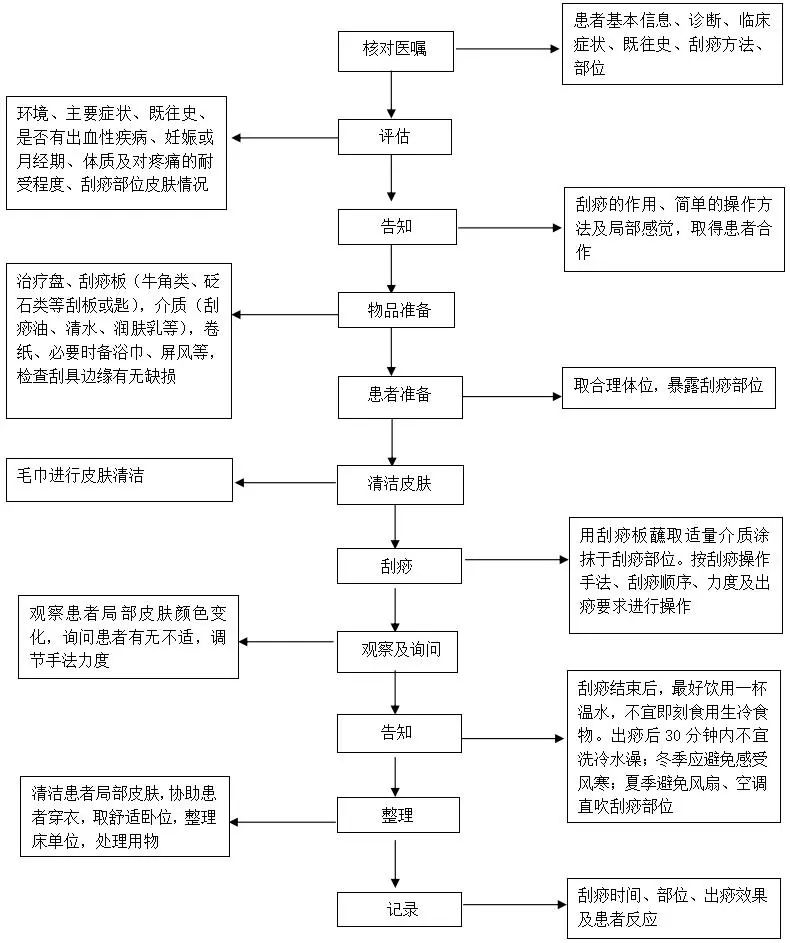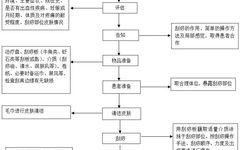
Gua Sha Technique
The Gua Sha technique is guided by the theory of meridians and acupoints in Traditional Chinese Medicine (TCM). It involves using blunt-edged tools, such as those made from horn or Bian stone, to scrape the skin after applying Gua Sha oil, water, or other lubricants. This scraping motion is performed repeatedly on specific areas of the body to produce petechiae, which helps to open the pores, expel pathogenic factors, promote the flow of Qi and blood, harmonize organ functions, and achieve disease prevention and treatment through this external TCM therapy.
Applicable Scope
It is suitable for discomfort caused by external pathogenic diseases, such as high fever, headache, nausea, vomiting, abdominal pain, and diarrhea; as well as pain caused by various bone and joint diseases, such as low back pain and shoulder pain.
Assessment
1. The environment of the treatment room should be comfortable, with an appropriate temperature.
2. Assess the main symptoms and medical history, checking for bleeding disorders, pregnancy, or menstruation.
3. Evaluate the patient’s constitution and pain tolerance.
4. Examine the skin condition of the area to be treated.
Information to Provide
1. Explain the effects of Gua Sha, the basic operation methods, and the sensations experienced during the procedure.
2. Inform the patient that the skin in the Gua Sha area may experience slight pain or a burning sensation, and they should notify the nurse immediately if they feel uncomfortable during the procedure.
3. The appearance of red-purple spots or bruises in the Gua Sha area is normal and will dissipate in a few days.
4. After Gua Sha, it is best to drink a cup of warm water and avoid consuming cold foods immediately. Do not take a cold shower within 30 minutes after the treatment.
5. In winter, avoid exposure to wind and cold; in summer, avoid direct airflow from fans or air conditioning on the treated area.
Preparation of Materials
Prepare a treatment tray, Gua Sha board (made from horn, Bian stone, etc.), medium (Gua Sha oil, clean water, moisturizing lotion, etc.), towels, rolls of paper, and if necessary, a bath towel, screen, etc.
Basic Operation Method
1. Verify the medical order, assess the patient, determine the Gua Sha area according to the medical order, ensure the bladder and bowels are empty, and provide explanations.
2. Check the scraping tool for any damage. Gather all materials and bring them to the bedside.
3. Assist the patient into a comfortable position, exposing the Gua Sha area while ensuring privacy and warmth.
4. Use the Gua Sha board to apply an appropriate amount of medium to the Gua Sha area.
5. Hold the board with one hand, placing it in the palm, and use the thumb, index, and middle fingers to grip the board, while the ring and little fingers rest against the edges. Adjust the angle of the board to maintain approximately a 45° angle with the skin, using the elbow as a pivot to move the forearm rhythmically.
6. The scraping order is generally from head and face to hands and feet, from the lower back to the chest and abdomen, from upper limbs to lower limbs, and from the inner side to the outer side in sequence.
7. Apply even pressure, starting lightly and increasing to a level the patient can tolerate, scraping in one direction without back-and-forth motions. Generally, scrape until the skin shows red-purple discoloration, or until small, raised spots or streaks appear, accompanied by local warmth or slight pain. For patients who do not easily develop petechiae or have minimal response, do not force the issue.
8. Observe the patient’s condition and changes in skin color, asking if they feel any discomfort, and adjust the technique accordingly.
9. Generally, scrape each area 20-30 times, with local Gua Sha lasting about 5-10 minutes.
10. After Gua Sha, clean the treated area, assist the patient in dressing, place them in a comfortable position, and tidy the treatment area.
Precautions
1. Before operation, understand the patient’s condition, especially noting that Gua Sha is not suitable for those with severe cardiovascular diseases, liver or kidney dysfunction, bleeding disorders, infectious diseases, extreme weakness, skin abscesses, or allergies.
2. Gua Sha should not be performed on an empty stomach or immediately after a large meal.
3. Gua Sha is not suitable for acute sprains or skin with swelling or ulceration.
4. Patients who are uncooperative, such as those who are intoxicated, have schizophrenia, or are convulsing, should not undergo Gua Sha.
5. Pregnant women should not have Gua Sha performed on the abdomen or lower back.
6. If the patient experiences dizziness, palpitations, cold sweats, pale complexion, nausea, or even fainting during Gua Sha, the procedure should be stopped immediately, and the patient should lie down flat. Notify the doctor for immediate assistance.
Appendix 1: Common Gua Sha Techniques
1. Light Scraping Method
The scraping board applies minimal pressure to the skin, causing no pain or discomfort to the recipient. After light scraping, the skin may only appear slightly red without bruising. This method is suitable for elderly, frail individuals, sensitive areas, and patients with deficiency syndromes.
2. Heavy Scraping Method
The scraping board applies greater pressure to the skin, within the patient’s tolerance. This method is suitable for the lower back, sides of the spine, areas with rich soft tissue in the lower limbs, and for strong, healthy young adults with excess heat or pain syndromes.
3. Fast Scraping Method
The scraping frequency exceeds 30 times per minute. This method is suitable for robust individuals and is primarily used on the back and limbs, especially for patients with acute or externally contracted diseases.
4. Slow Scraping Method
The scraping frequency is less than 30 times per minute. This method is mainly used on the head, face, chest, and inner thighs, particularly for chronic patients with internal conditions or deficiency.
5. Straight Line Scraping Method
Also known as the straight board scraping method. This involves scraping the skin in straight lines of a certain length. This method is suitable for relatively flat areas of the body, such as the back, chest, and limbs.
6. Curved Scraping Method
The scraping direction is curved, resulting in curved marks on the skin. The scraping direction often follows the muscle fibers or is determined by the skeletal structure. This method is suitable for the intercostal spaces of the chest and back, as well as around the shoulder and knee joints.
7. Rubbing Method
Directly press the scraping board against the skin or use a cloth barrier to perform regular circular or linear movements, generating warmth in the skin. This method is suitable for areas with numbness, tightness, or dull pain, such as the inner shoulder, lower back, and abdomen; it can also be used before Gua Sha to help the patient relax.
8. Combing Scraping Method
Using the scraping board or comb, scrape from the hairline at the forehead, specifically at the temples, towards the back of the head in a regular, unidirectional manner, similar to combing hair. This method is suitable for headaches, dizziness, fatigue, insomnia, and mental tension.
9. Point Pressure Method (Acupoint Method)
Directly press the acupoints with the corners of the scraping board, gradually increasing the pressure to the patient’s tolerance, holding for a few seconds before quickly lifting the board. Repeat this 5-10 times. This method is suitable for acupoints in fleshy areas or for areas where scraping cannot reach deeply or is not suitable for direct scraping, such as Hui Tiao, Wei Zhong, Du Bi, and the spaces between the spinous processes of the back.
10. Pressing and Rubbing Method
Press and rub the scraping board on the acupoints, alternating between pressing and rotating. The scraping board should remain in contact with the skin without sliding, performing 50-100 presses per minute. This method is suitable for acupoints such as Tai Yang, Qu Chi, Zu San Li, Nei Guan, Tai Chong, Yong Quan, and San Yin Jiao.
11. Angle Scraping Method
Using an angled scraping board or allowing the edges of the board to contact the skin at a 45° angle, scrape from top to bottom or from inside to outside. This method is suitable for the joints of the limbs, the sides of the spine, and around the shoulder joints, such as Feng Chi, Nei Guan, He Gu, and Zhong Fu acupoints.
12. Edge Scraping Method
Use the long edge of the scraping board for scraping. This method is suitable for larger areas, such as the abdomen, back, and lower limbs.
Appendix 2: Gua Sha Technique Operation Flowchart

Source: National Administration of Traditional Chinese Medicine
Copyright belongs to the original author. If there is any infringement, please contact us for modification or deletion. Contact number: 0731-85054048
Recommended Reading
Join Group: Various specialized nursing WeChat groups, join now
Submissions:Original articles related to nursing are welcome for submission
Video Account: Nursing tips and expert live broadcasts
Follow: WeChat public account categorized by nursing departments
Buy Books:Nursing books, click “Read More” below to purchase

